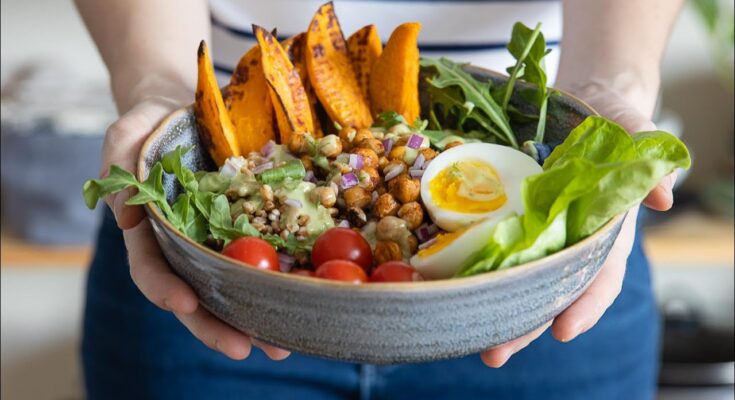Healthy Recipes: Let’s be real—eating healthy sounds great, but figuring out where to start can feel like trying to solve a Rubik’s Cube… blindfolded. But here’s the thing: healthy eating doesn’t have to be complicated, bland, or boring. In fact, it can be downright delicious, satisfying, and energizing once you’ve got a few go-to recipes under your belt.
When you prepare meals at home, you’re not just filling your belly—you’re fueling your body the right way. You control what goes in, avoid sketchy preservatives, and skip the excessive sugar, salt, and fat found in most processed foods.
This guide will walk you through everything—from ingredients to recipes to prep tips—so you can whip up healthy meals with confidence. Whether you’re a kitchen newbie or a seasoned cook looking for cleaner recipes, you’ll find something here to love (and eat!).
Essential Ingredients You’ll Need
Before diving into recipes, let’s stock your kitchen with the good stuff. The foundation of healthy eating starts with quality ingredients.
1. Fresh Produce
Vegetables and fruits should be the stars of your meals. They’re packed with vitamins, minerals, fiber, and antioxidants. Think:
- Leafy greens (spinach, kale, arugula)
- Cruciferous veggies (broccoli, cauliflower)
- Colorful fruits (berries, oranges, apples, bananas)
- Root veggies (carrots, sweet potatoes)
The more color on your plate, the better. Each color represents different nutrients your body craves.
2. Lean Proteins
Protein keeps you full and fuels muscle growth. Opt for:
- Chicken breast
- Turkey
- Fish (salmon, tuna, cod)
- Tofu and tempeh
- Eggs
- Legumes (lentils, black beans, chickpeas)
Protein is your kitchen MVP—it fits into nearly every meal, from breakfast to dinner.
3. Whole Grains
Forget refined carbs. Whole grains give you energy without the crash.
- Quinoa
- Brown rice
- Whole wheat pasta
- Oats
- Barley
They’re rich in fiber and help you feel satisfied for longer.
4. Healthy Fats
Yes, fat can be good for you—if it’s the right kind.
- Avocados
- Nuts and seeds (chia, flax, walnuts)
- Olive oil
- Fatty fish
These fats support brain function, heart health, and taste incredible.
5. Herbs & Spices
These are flavor powerhouses with almost zero calories:
- Basil, parsley, cilantro
- Garlic, onion, ginger
- Turmeric, cumin, paprika
- Black pepper, cayenne
Ditch the salt shaker—season with spices instead!
Pantry Staples for Healthy Cooking
Think of your pantry as your healthy-cooking toolkit. With the right staples, you’re always minutes away from a nourishing meal.
- Oils & Vinegars: Extra virgin olive oil, coconut oil, balsamic vinegar, apple cider vinegar
- Canned Goods: Low-sodium beans, diced tomatoes, tuna
- Grains: Rolled oats, quinoa, brown rice
- Nut Butters: Natural peanut or almond butter (check for no added sugar)
- Seasonings: Sea salt, pepper, garlic powder, Italian seasoning
- Broths: Low-sodium vegetable or chicken broth
Having these on hand means fewer grocery runs and faster cooking. Smart pantry, happy life.
Must-Have Kitchen Tools for Easy Prep
You don’t need a fancy kitchen—just the right tools:
- Blender or Food Processor: For smoothies, sauces, soups
- Non-Stick Skillet: Healthier cooking with less oil
- Steamer Basket: Preserve nutrients in veggies
- Sharp Chef’s Knife: Makes chopping easier and safer
- Measuring Cups and Spoons: Keep portions in check
- Cutting Board: Preferably two—one for produce, one for raw meat
Quality tools save time, reduce stress, and make you feel like a total pro—even if you’re just making scrambled eggs.
Healthy Breakfast Recipes
Greek Yogurt Parfait
Ingredients:
- 1 cup plain Greek yogurt
- ½ cup mixed berries (blueberries, raspberries, strawberries)
- 2 tbsp granola
- 1 tsp honey (optional)
- Chia seeds for topping
Step-by-Step Guide:
- Scoop the Greek yogurt into a glass or bowl.
- Layer with fresh berries.
- Sprinkle granola on top for crunch.
- Drizzle with honey if you like it a bit sweeter.
- Finish with a dash of chia seeds.
This takes under 5 minutes and tastes like dessert—but it’s loaded with protein, probiotics, and antioxidants.
Veggie Omelette
Ingredients:
- 2-3 eggs (or egg whites)
- ¼ cup chopped bell peppers
- ¼ cup diced tomatoes
- ¼ cup spinach
- 1 tbsp olive oil
- Salt and pepper to taste
Step-by-Step Guide:
- Heat olive oil in a non-stick pan over medium heat.
- Add the veggies and sauté for 2-3 minutes.
- In a bowl, whisk the eggs with salt and pepper.
- Pour eggs over the veggies in the pan.
- Cook until set, fold, and serve.
This omelette is your protein-packed powerhouse. Swap veggies based on what’s in your fridge. It’s that flexible.
Wholesome Lunch Ideas
Grilled Chicken Salad
Ingredients:
- 1 grilled chicken breast (sliced)
- 2 cups mixed greens (spinach, arugula, romaine)
- ½ cup cherry tomatoes (halved)
- ¼ cucumber (sliced)
- ¼ red onion (thinly sliced)
- 1 tbsp olive oil
- 1 tbsp balsamic vinegar
- Salt and pepper to taste
Step-by-Step Guide:
- Start by grilling the chicken breast—season with a little salt, pepper, and olive oil. Grill for 6–7 minutes on each side or until cooked through.
- While the chicken is cooking, prepare your salad base. Toss the greens, cherry tomatoes, cucumber, and onion into a large bowl.
- Slice the cooked chicken and place it on top of the salad.
- Drizzle with olive oil and balsamic vinegar.
- Toss gently, season if needed, and enjoy!
This salad isn’t your sad desk lunch—it’s hearty, colorful, and full of flavor. Perfect for a light yet filling midday meal.
Quinoa & Roasted Veggie Bowl
Ingredients:
- 1 cup cooked quinoa
- ½ cup chopped sweet potato
- ½ cup broccoli florets
- ½ bell pepper, sliced
- 1 tbsp olive oil
- 1 tsp garlic powder
- Salt and pepper to taste
- Optional: tahini or hummus for drizzle
Step-by-Step Guide:
- Preheat your oven to 400°F (200°C).
- Toss the sweet potatoes, broccoli, and bell peppers with olive oil, garlic powder, salt, and pepper. Spread them on a baking sheet and roast for 20–25 minutes.
- While the veggies roast, cook the quinoa according to package instructions.
- Once done, assemble your bowl: base of quinoa, topped with roasted veggies.
- Optional but amazing: drizzle tahini or a spoonful of hummus on top for extra creaminess.
This bowl is a plant-based powerhouse—high in fiber, protein, and nutrients. It’s meal-prep friendly and perfect hot or cold.
Clean and Filling Dinners
Baked Salmon with Asparagus
Ingredients:
- 1 salmon fillet
- 1 bunch of asparagus, trimmed
- 1 tbsp olive oil
- 1 tsp lemon juice
- 1 clove garlic (minced)
- Salt, pepper, and dill (optional)
Step-by-Step Guide:
- Preheat your oven to 375°F (190°C).
- Place the salmon on a baking tray lined with parchment paper. Season with salt, pepper, garlic, and a drizzle of lemon juice.
- Toss the asparagus in olive oil, season lightly, and spread it beside the salmon.
- Bake for 15–18 minutes until salmon flakes easily with a fork.
- Sprinkle with fresh dill before serving if you like.
This dinner screams gourmet but takes minimal effort. Plus, it’s rich in omega-3s, protein, and fiber.
Chickpea Stir Fry
Ingredients:
- 1 can chickpeas (rinsed and drained)
- 1 cup broccoli florets
- ½ bell pepper (sliced)
- ½ onion (sliced)
- 1 tbsp olive or sesame oil
- 1 tbsp low-sodium soy sauce
- 1 tsp grated ginger
- 1 clove garlic (minced)
Step-by-Step Guide:
- Heat oil in a large skillet or wok.
- Add garlic and ginger—sauté for 30 seconds until fragrant.
- Toss in the veggies and stir-fry for 3–4 minutes.
- Add chickpeas and soy sauce. Cook another 4–5 minutes until everything is heated through and slightly caramelized.
- Serve as-is or over brown rice or quinoa.
This one-pan dish is quick, satisfying, and budget-friendly. Chickpeas are a great meatless protein source, and the ginger-garlic combo brings the flavor home.
Snacks That Are Actually Good for You
Let’s face it: we all snack. But instead of reaching for chips or candy, try these clean, energizing options.
1. Hummus with Veggies
- Pair hummus with carrot sticks, cucumber slices, or bell pepper strips.
- It’s creamy, crunchy, and packed with fiber and plant protein.
2. Chia Pudding
Ingredients:
- 3 tbsp chia seeds
- 1 cup almond or oat milk
- ½ tsp vanilla extract
- Optional: berries or sliced banana
Mix ingredients in a jar, refrigerate overnight, and wake up to a creamy, pudding-like snack. Add fruit for extra sweetness.
These snacks satisfy without spiking your blood sugar, making them ideal for in-between meals or late-night munchies.
Guilt-Free Desserts
Who says healthy eating means skipping dessert? These recipes are sweet, satisfying, and secretly good for you.
Banana Nice Cream
Ingredients:
- 2 ripe bananas (sliced and frozen)
- 1 tsp vanilla extract
- Optional: cocoa powder or peanut butter
Step-by-Step Guide:
- Add frozen bananas and vanilla to a food processor.
- Blend until smooth and creamy.
- Add cocoa or nut butter if you want extra flavor.
- Serve immediately or freeze for a firmer texture.
This treat is dairy-free, low in sugar, and tastes like real ice cream. Kids love it too!
Baked Apples with Cinnamon
Ingredients:
- 2 apples (cored and halved)
- 1 tsp cinnamon
- 1 tsp maple syrup or honey
- Optional: chopped nuts or raisins
Step-by-Step Guide:
- Preheat oven to 350°F (175°C).
- Place halved apples in a baking dish.
- Sprinkle with cinnamon and drizzle with syrup.
- Bake for 25–30 minutes until tender.
- Top with nuts or raisins if desired.
Warm, sweet, and comforting—this dessert feels indulgent but is made with wholesome ingredients.
Tips for Meal Prepping Healthy Recipes
Meal prepping is the secret sauce to staying consistent with healthy eating—even on the busiest days. Imagine opening your fridge and having grab-and-go meals ready. No stress, no decision fatigue, just healthy food waiting for you. Here’s how to get started:
1. Plan Your Menu
Start simple. Pick 2-3 recipes for lunch and dinner that you can rotate throughout the week. Don’t forget to include breakfasts and snacks. Write down everything you’ll need and create a grocery list to avoid wandering the aisles (or the food delivery app).
2. Batch Cook Staples
Cook big batches of:
- Quinoa or brown rice
- Roasted veggies
- Hard-boiled eggs
- Chicken breasts or tofu
- A simple sauce or dressing (like tahini or yogurt-based)
Having these on hand means you can mix and match to create multiple meals.
3. Use the Right Containers
Invest in quality glass containers or BPA-free plastic ones with compartments. Label them with the date to keep track of freshness. Use mason jars for layered salads or chia puddings.
4. Keep It Colorful
The more color in your meal prep, the more variety of nutrients you’re getting. Make your meal box look like a rainbow—sweet potatoes, spinach, tomatoes, chickpeas, purple cabbage, etc.
5. Freeze Smart
Make freezer-friendly recipes like soups, chili, or veggie burgers. These are lifesavers on nights when you’re too tired to cook.
Meal prepping might seem like a Sunday chore, but the midweek payoff is totally worth it. You’ll save time, money, and stay on track without second-guessing yourself at dinner.
Understanding Nutrition Labels
Have you ever picked up a “healthy” snack only to find it’s loaded with sugar and sodium? That’s where label reading comes in. It’s like decoding food’s secret language—and once you learn it, you’re in control.
1. Check the Serving Size First
Everything on the label is based on one serving. Sometimes, a small snack bag contains two or three servings—which means double or triple the calories, sugar, and fat.
2. Focus on Ingredients
Look for:
- Whole foods first (whole grain oats, almonds, etc.)
- Minimal ingredients (if it reads like a science experiment, pass)
- Avoid: hydrogenated oils, high-fructose corn syrup, artificial dyes
3. Sugar and Sodium Awareness
Sugar hides behind names like cane juice, maltose, and syrup. Try to stay under 25g added sugar daily. Sodium can sneak up fast, especially in canned and processed foods. Aim for less than 2,300 mg per day.
4. Fiber and Protein Are Your Friends
Look for:
- 3g+ fiber per serving
- At least 5g of protein (for snacks)
Learning labels empowers you to shop smarter and eat cleaner—no diet necessary.
Substitutes for Common Unhealthy Ingredients
Eating healthy doesn’t mean giving up your favorite dishes. It’s all about swapping, not sacrificing. Here’s how to make better choices without losing flavor:
| Unhealthy Ingredient | Healthy Swap |
|---|---|
| White rice | Brown rice, quinoa, cauliflower rice |
| Sugar | Honey, maple syrup, mashed banana |
| Butter | Avocado, olive oil, Greek yogurt |
| Sour cream | Greek yogurt |
| Heavy cream | Coconut cream or cashew cream |
| White flour | Almond flour, oat flour, whole wheat flour |
These swaps help reduce empty calories and boost nutrients. You’ll still get the textures and flavors you love—just with better ingredients.
Common Mistakes in Healthy Cooking
Let’s be honest—healthy cooking isn’t always perfect. Sometimes your quinoa turns to mush, or your roasted veggies are… not quite roasted. Here are common pitfalls and how to avoid them:
1. Overcooking Veggies
Steaming or roasting too long turns vibrant veggies into bland, soggy blobs. Tip: Roast at high heat (400°F+) and steam lightly for just a few minutes. Keep that crunch!
2. Drowning Food in Oil
Olive oil is healthy—but not in half a cup. Use a brush or spray to lightly coat your pan or veggies. You’ll save calories without losing flavor.
3. Ignoring Portion Sizes
Even healthy food can lead to weight gain if portions are too large. Use your palm as a protein guide, your fist for carbs, and your thumb for fats.
4. Skipping Seasoning
Healthy doesn’t mean tasteless. Use garlic, lemon juice, spices, and fresh herbs to make your meals pop. Don’t rely solely on salt for flavor.
5. Cooking Everything From Scratch Every Day
That’s a fast track to burnout. Instead, meal prep or cook double portions to save time during the week.
Learning from these slip-ups makes you a better, more confident home cook. Remember, it’s a journey—progress, not perfection.
How to Stay Consistent with Healthy Cooking
Let’s face it—motivation isn’t always there. Life gets busy, takeout gets tempting, and cooking can feel like a chore. But consistency is where real results happen. Here’s how to stick with it:
1. Make It Fun
Turn cooking into an experience. Play music, listen to a podcast, cook with a friend, or try themed dinner nights (Taco Tuesday, Stir-Fry Saturday). When it’s fun, it’s sustainable.
2. Keep It Simple
You don’t need elaborate recipes every night. A grain, a veggie, and a protein = a balanced meal. Master 3–5 simple recipes you can rotate and riff on.
3. Celebrate Small Wins
Cooked 3 meals this week instead of eating out? That’s a win. Packed your lunch for work? Huge win. Celebrate progress, not perfection.
4. Get the Whole Family Involved
Kids can stir, chop (with supervision), or set the table. When everyone’s involved, it feels less like a solo task and more like a team effort.
5. Remember Your Why
Write down your reasons for eating healthy—more energy, better skin, saving money, long-term health—and post it somewhere visible. On tough days, it’ll keep you grounded.
Sticking with healthy cooking isn’t about willpower. It’s about building routines and making them enjoyable.
FAQs about Healthy Recipes
1. Can I meal prep all the recipes listed here?
Yes! Most of these recipes are meal-prep friendly. Just store them in airtight containers in the fridge and reheat when ready. Salads and raw veggies are best stored separately from dressings.
2. Are healthy recipes more expensive?
Not necessarily. Buying in bulk, using pantry staples, and cooking at home saves money long-term compared to ordering takeout or buying processed health foods.
3. Can kids enjoy these meals too?
Absolutely. Many of these recipes are kid-friendly or can be easily adjusted for picky eaters—just use milder spices or present ingredients in fun ways.
4. What’s the best way to store these meals?
Use glass containers for longer shelf life. Keep sauces and wet ingredients separate until you’re ready to eat. Most meals last 3–5 days in the fridge, some can be frozen.
5. How do I add more flavor without using too much salt?
Spices, herbs, lemon juice, vinegar, garlic, onion, and even a little mustard or yogurt can go a long way in enhancing flavor without the sodium.
Conclusion
Healthy eating isn’t about being perfect. It’s about making better choices—most of the time. With the right ingredients, some solid go-to recipes, and a plan you actually enjoy following, you’ll find that healthy food can be comforting, energizing, and absolutely delicious.
This step-by-step guide gave you more than just recipes—it gave you tools to make nutrition part of your lifestyle, not just a 2-week experiment. From morning parfaits to evening salmon, everything here is designed to fuel your body, keep you full, and satisfy your cravings—all without guilt.
Now it’s your turn. Pick a recipe, prep your kitchen, and start cooking your way to better health—one tasty meal at a time.



